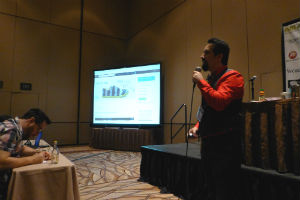 Leveraging your audience for blog post ideas is common practice in content marketing and it can generate unique ideas from a customer-side perspective. But what does it take to use crowdsourcing as a tool for generating influence? Brands frequently target thought leaders to help amplify their content, but what is the best way to collect these resources?
Leveraging your audience for blog post ideas is common practice in content marketing and it can generate unique ideas from a customer-side perspective. But what does it take to use crowdsourcing as a tool for generating influence? Brands frequently target thought leaders to help amplify their content, but what is the best way to collect these resources?
Dino Dogan, founder of influencer marketing service Triberr, proclaimed a new age of crowdsourcing influence at his NMX content marketing super session. Dogan summarized his perspective with a simple question for brands: If your customers doesn’t know the brand, why would they trust its assessment of itself?
Dogan argued that brands should identify a group of influencers – bloggers, podcasters, Youtubers, etc. – to become paid brand advocates. These influencers could then pool their small, dedicated audiences together (in “tribes”) and spread the brand’s good word. They are members of the “creative class”, adept at creating compelling content where companies and brands often fall short.
By crowdsourcing these influencers, brands can utilize their creative talents and expand reach among dedicated audiences. Here are 5 specific tips Dogan offered to help brands crowdsource their influence:
1). Focus on the intimacy of the audience, not the size.
Nike has Michael Jordan as its paid influencer, but there’s only one of him so marketers will have to settle for someone else. An influencer with an intimate, loyal following is a great choice and can produce great results for the brand. Bloggers are celebrities with these audiences, regardless of the size. Dogan argued that small size is not automatically a detriment – in fact, it can be a valuable resource if that audience is dedicated.
2). Apply an indirect approach to brand marketing.
Many brands follow the direct approach to influencer generation – brands talking about themselves to their audiences. But what if brands and marketers applied an indirect approach, recruiting influencers and letting them promote the brand? Consumers are more likely to believe recommendations from people they know, so why not take advantage of their expertise and passion for the brand’s benefit? This is the foundation of crowdsourcing influence – brands are trading some messaging control for the chance at increasing a loyal influencer team.
3). Allow the influencers to advocate for themselves.
It’s best practice in content marketing to connect with thought leaders for content amplification. But, rather than choosing influencers to represent the brand, why not have them come to you? Dogan’s service Triberr allows brands to create campaign pages – essentially a Kickstarter page for brands – and have potential influencers advocate for themselves as brand representatives.
Have the brand list the price, campaign duration, and other pertinent information on the campaign page, then enable people to apply to become an influencer. This way, they are signaling willingness to dedicate time and effort for brand promotion. Back-end campaign managers can then pick from the list of applications, and identify which candidates fit best for the company’s messaging strategy.
4). Pool the resources of these influencers.
If you’re able to hire a good group of brand influencers (whether it’s 20, 50, 100, etc.), have them then share their audiences and resources with each other. If everyone is part of the same mission, with the same milestones, payout, timeframe and assets, you can achieve a greater level of collaboration.
5). Allow the influencers to track themselves.
You don’t need to stop crowdsourcing when your team is in place. Tracking results can be team-wide production as well. Dogan emphasized the intrinsic motivation of his crowdsourced model — when you have 100 influencers working together, sharing audiences, and tracking results, this means that every time you publish a blog post, you are guaranteed at least 100 shares.
What happens when you get the right brand working with the right influencers? Dogan believes you generate “home–cooked, meaningful content”, which differs from the “fast-food, meaningless content” often found on the Internet.


